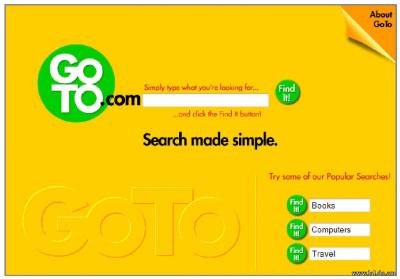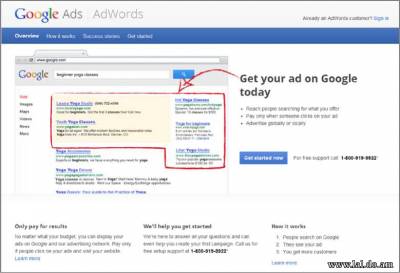The Origins of Google AdWords
In 1996, a small company was formed that would forever change the world of Internet marketing. This company was called Idealab. It took two years of hard work and creative ideas before Bill Gross’s company would launch GoTo.com with a simple business model: Advertisers could choose to display their ads based on what a searcher was trying to find. A searcher would type a query into the search box (Figure 1.1), and if advertisers chose to advertise on that word, their ad would show in the search results. Four simple concepts made this business model revolutionary. Figure 1.1 GoTo.com's search page, circa 1998 The first was relevance, a word later adopted by Google throughout their AdWords program. Showing ads based on what someone was actively seeking made these new search ads more relevant than anything previously displayed on the Internet.
Advertisers would only choose to display their ads on keyword searches that were related to their products or services. Since their ads would then only be shown when someone was searching for related information, these ads would help the searchers find what they were seeking. Before the days of PPC, the ads alongside a search results page were often banner ads that had nothing to do with the search query. While these ads did gather many impressions (an “impression” is when an ad is shown on a page), they were not relevant to the user and thus were rarely clicked. Advertisers were paying for exposure but were not receiving much traffic for their ad dollars. In the early days of Google, before AdWords launched, the founders of Google had been questioned many times by their investors about how they would eventually monetize their search engine. At that time, the founders did not have an answer; however, they held steadfast to the belief that at the moment someone was shown a page of search results, Google had their undivided attention. It would be in that moment of someone scanning a page of search results that Google would make its money. It turned out to be an accurate observation by the early Googlers. By displaying ads based on what someone was actively seeking, GoTo.com formed a synergy between searchers and advertisers that helped both reach their goals on a single search page. Advertisers would receive visitors who were actively seeking their products, and searchers would find products that were related to what they were seeking. This was a win for both searchers and advertisers. The second concept was the pricing model. Previously, almost all advertisements were based on paying for impressions. A company would decide how many impressions they would like to buy for their banner ads, and then they would pay on a cost per thousand impressions (CPM) basis. This created a scenario where you had to have a large advertising budget to even sign an initial contract. In addition, you had no idea how many visitors or sales those ads would bring to your site. The world of Internet advertising was mostly formed by larger companies or companies with venture capital backing. By changing to a PPC pricing model, advertisers paid only when they received traffic. This shift to performance-based advertising allowed companies to try a fledgling business model with little monetary commitment. The minimum monthly spend was roughly $1 per day, a big change from minimums that were often several thousand dollars a month. Because search engines were paid only when a click occurred, it also forced search engines to show only relevant ads. If an ad did not get clicked, the search engine did not make money. The pricing model helped reinforce that only relevant ads should be shown on a search results page. This forced advertisers and search engines to work together to create a better search page for the consumer. The third concept—and how Yahoo!, Bing, and Google have built a base of more than a million advertisers—was the signup process. GoTo.com removed the barrier of a salesperson between the advertiser and the inventory. Using a self-serve ad model, any advertiser could sign up for a PPC account and start selecting keywords and creating ad copy within minutes (Figure 1.2).
Figure 1.2 The AdWords signup process is a simple wizard influenced by GoTo.com. By choosing a self-serve model, a search engine did not have to pay commission to a salesperson. There were no contracts to sign, no insertion orders (IOs) to fax, and no phone calls to be made before you could start advertising on the Web. This straightforward approach allowed anyone, from a small business to a Fortune 500 company, to quickly experiment with Internet advertising. The Internet was still a new concept to most people, and both companies and consumers were unsure how widely adopted the Web would become. Thus, having the ability to commit a few dollars and experiment with the new medium was paramount to introducing thousands of new companies to the concept that they could make money on the Web. It also enabled the search engines to scale their advertiser base quickly. People often slow down the advertising process, and allowing a self-serve model meant that the only barrier to advertising was a bit of time and a credit card. The last concept is what has allowed Yahoo!, Bing, and Google to make billions of dollars from their advertisers—the auction process. GoTo.com did not have a set price for what you needed to pay when a keyword was clicked in a search result. Advertisers set a price of what they were willing to pay, and the company willing to pay the most showed up highest in the search results. If you were willing to pay more than your competitors, then your ad would show higher in the search results, which would gather more clicks and bring more visitors to your website. It is easy to see how the top positions were highly coveted. The process has become much more complex over the years as search engines, users, and advertisers have become savvier. In October 2001, GoTo.com, Inc., renamed itself Overture Services. In 2003, Overture was acquired by Yahoo! for $1.63 billion. In 2009, Microsoft and Yahoo! formed the Search Alliance. With this new deal, Yahoo! would now serve ads from Microsoft’s adCenter platform, now known as Bing Ads, and the original PPC engine would no longer be used by anyone.
Today, GoTo.com is an unknown name to most people; in fact, GoTo.com is no longer owned or operated by Yahoo! and has changed hands a few times over the years. As described earlier, GoTo.com’s four founding concepts were quite simple: relevance, pay-per-click pricing, self-service, and auction-based pricing. However, these principles were combined not only to quickly gain advertiser adoption, but also to reap the monetary benefits of advertiser competition for the top ad positions.
Google Enters the Arena In 1998, when GoTo.com was first launching, Google’s search engine was just renamed from BackRub and was running on Stanford University servers. Creators Larry Page and Sergey Brin were more concerned with moving their operations into Susan Wojcicki’s garage than making money.
Over the next two years, Google moved to Mountain View, accepted $25 million in funding, and hired key employees to help in their evolution. Their early hires revolved around scaling their search technology. Craig Silverstein was their very first employee and served as the director of technology. Much of his early work helped scale the IT operations that would allow Google to grow. The next step was finding a way to start making money. Google’s first offering was an uninspired CPM program. To advertise with Google, you had to talk to a sales rep and sign a contract for a fairly high minimum spend. Although advertisers could choose to show an ad based on a searcher’s query, the four concepts that had made GoTo.com a success were not to be found. The high barrier to advertising with Google was lowered in October 2000 when Google launched their first self-serve advertising program. The simply named Google AdWords started with 350 customers. However, AdWords was still bought on a CPM basis.
Google AdWords Select Revolutionizes PPC February 2002 will always be remembered as the time when Google forever changed pay-per-click advertising. Google launched AdWords Select, which incorporated all of GoTo.com’s founding principles; however, in typical Google fashion, they added their own twist to the auction model. On GoTo.com, the more you paid, the higher your ad appeared in search results. That essentially made it so the company willing to pay the most had the highest visibility. Google’s main advertising word was relevance, and they changed the PPC auction model both to increase relevance for a searcher and to maximize how much money Google made on a search results page. Their twist was to incorporate click-through rates (CTR) in determining where an ad showed up in the results. They used a simple formula to determine ad position: maximum CPC (cost per click) multiplied by CTR. The logic was that if an ad was clicked more often, it was more relevant to the searcher, and the advertiser should be rewarded for showing an ad aligned with the searcher’s query. This simple formula also maximized the dollars Google made on every single search engine results page (SERP). In the PPC model, a search engine is paid only when a click occurs. On GoTo.com, if advertisers were willing to bid more than everyone else for a click, their ads would show up at the top of the search pages. If those same ads did not receive clicks, the engines did not actually make money from displaying those ads. Therefore, a search engine should not display the highest bid ads the most if they were not clicked. A search engine would make more money by displaying lower-bid ads that gathered clicks than by showing high-cost ads that received few clicks.
By incorporating a combination of bid prices and how many clicks those ads received, Google managed to maximize how much they made on any single search results page. This simple change also created an environment where a small company with a more compelling offer could have its ad displayed higher in a SERP than a large national company that did not take the time to create relevant ads. Price no longer trumped relevancy. Having the most money did not ensure the most clicks or visibility. Advertisers had to choose keywords that were relevant to their products and create ads to match. This level playing field helped spur advertiser adoption to the point that Google eventually dropped their CPM program completely and renamed the AdWords Select program to the name used today: Google AdWords. Over the years, Google has become much more sophisticated and has revamped their formulas for displaying ads on search pages. However, throughout the growing complexities of AdWords, Google has always kept their ad serving synergistic with the search process. To understand how to take advantage of aligning your advertising efforts with Google’s ad serving, it is important to understand the psychology of search.
© Advanced Google Adwords: 3rd edition >>> Back to TABLE OF CONTENTS <<< | |
| Views: 470 | |
| Total comments: 0 | |

